by Winding Pathways | Nov 14, 2024 | Birds, Nature
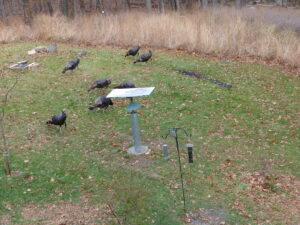
Turkeys sweep up all available seeds.
While feasting on a recent turkey dinner we glanced outside to see enthusiastic hungry wild turkeys trotting towards us. Hunters consider the gigantic birds wary and elusive. Ours aren’t. Whenever we scatter birdseed, they dash from the woods and sometimes even follow us when they see us carrying the can that holds seed.
Turkeys are fun to watch and delicious to eat. Beef, pork, lamb, and chicken all originated in the Old World and were brought to North America during early settlement days. The turkey is the only major American native food animal that’s today eaten around the glove. It took a double route to the dinner table.
Turkeys Crossing the Ocean…
Early European explorers discovered wild turkeys in the vast forests of eastern North America and watched their domesticated cousins scratching around Native American villages, especially in Mexico and Central America. By the 1500s sailing ships bearing live domestic turkeys were heading for Europe, where they soon became an esteemed food. Today, European farmers produce about 13 million tons of the tasty birds.
…and Back Again
A century or so after being introduced to Europe, the Pilgrims brought domestic turkeys with them when they crossed the Atlantic westward. For the turkey species, it was their second ocean crossing. During the next 250 years, Americans ate both wild and domesticated turkeys.
Too Much of a Good Thing
They overdid it. Overhunting, combined with massive habitat destruction, reduced wild turkey numbers to around 30,000 by the early Twentieth Century. Although millions of domestic turkeys lived on farms, wild ones survived only in remote forests and swamps. They seemed on the verge of extinction.
Help for Endangered Turkeys
That quickly changed. Thanks to the efforts of the National Wild Turkey Federation and state wildlife agencies, turkeys made a remarkable comeback. Flocks were captured, moved to places that seemed suitable for them, and released. They quickly multiplied and began expanding.
When we moved to Iowa in 1978 biologists believed the husky birds could only survive in large forests. Iowa only has a few big woods where wild turkeys were released. Soon the birds proved the experts wrong. They began expanding and even moved into cities and towns. Wild turkeys are so common today that efforts to catch and move them to new habitats aren’t needed.
Turkey Sub-Species
The National Wild Turkey Federation’s website includes much about the history and habits of this remarkable bird. According to them, turkeys live almost coast to coast from Canada to Mexico in five subspecies.
The Eastern wild turkey lives across about half of the eastern portion of the United States. It has chestnut brown tips on its tail feathers. Gobblers can reach 30 pounds and sport a long beard. Hens are much smaller and sleeker.
The Osceola wild turkey makes its home in Florida. Its tail feathers are tipped in brown on a bird that’s smaller than the Eastern.
The Rio Grande’s tail feathers are tipped in tan. It’s also a smallish subspecies with only a medium length beard.
The Miriam’s sports white-tipped tail feathers. It lives in the mountain west. Although it has a short beard it can be as large as the eastern subspecies.
Finally, there’s the Gould’s wild turkey that only lives in Arizona, New Mexico, and parts of Mexico. It is the rarest subspecies.
There is also a totally separate wild turkey species. It’s the Ocellated. This gorgeous beardless bird lives only in southern Mexico, Belize, and Guatemala.
Turkey Behavior Entertains
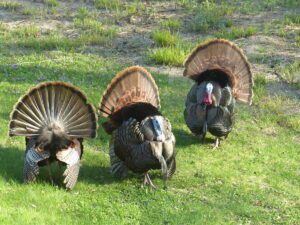
Showing off.
We never tire of hearing wild turkeys’ springtime gobbling, watching them strut, and sometimes spotting them fly up into tall trees in the late evening. How they keep warm enough to sleep in their treetop perches during blizzards astounds us. Turkeys are also fun to watch at our feeder, although they gobble up so many seeds there’s little left for smaller songbirds.
by Winding Pathways | Mar 14, 2024 | 1080 Labyrinth Blog, Labyrinths, Reflections/Profiles, Uncategorized
Who Is Stargirl?
Stargirl taught us to notice…to care. You know Stargirl, the spritely, hippie-seeming girl in the Jerry Spinelli story of the same title who showed up at a high school, wrote notes to people, played the ukelele, was nice to everyone, and even cheered the other team’s successes. She turned typical high school life upside down. And, then, vanished.
We walk today in her spirit. Usually ground underfoot is stone-cold and rigid. But with this “winter that hasn’t been” mole humps yield underfoot. We pause by the bell of the Phoenix Harmony Labyrinth.
Cookie Monster has nibbled the rim of the waning Gibbous moon as it slips west. Guided by moon shadows we walk.
-
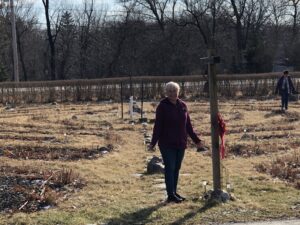
-
Teri blesses the labyrinth
-
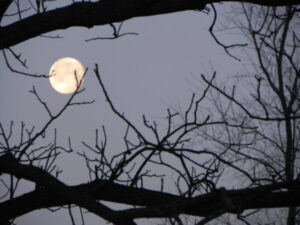
-
Tree branches help you watch the moon move across the sky.
From the south Mother West Wind shakes out the Merry Little Breezes. Off they skitter tickling the tops of the firs and rustling the winter-weary leaves of the Derecho-damaged oak.
Four Directions
Stop. Breathe in the air. Neither too cold nor too muggy. It’s Goldilocks. Just right.
To the east, a smear of red on the horizon separates the black earth from the velvet sky. Father Sun, starting to wake up, stretches his rosy fingers. Yet, stars still sprinkle the sky.
The ancient basswood tree full of gaping holes stands silhouetted. How did it survive when the sturdy oak shattered? Perhaps because it didn’t resist?
Totems
Vultures return in March. In fact, I saw one the other day soaring overhead. Checking out the basswood that has been home of vulture families for generations. Some people don’t like vultures because they are homely and eat dead stuff. Who among us is a Hollywood beauty?
As for eating dead stuff, good thing they do…One of Mother Nature’s cleanup crew. Otherwise, we would be knee-deep in rot. Maybe we are anyway. Good parents their keen eyesight and sharp smell lead them to meals which they feed their babies until they fledge.
Watching the young on their first flights as they swoop down, cross the labyrinth, then flap mightily to land in the fir on the far side is always a thrill. Vultures are good totems.
The pause by the birches feels like home. New England. Robert Frost wrote it well: “When I see birches bend to left and right Across the lines of straighter darker trees, I like to think some boy’s been swinging them. But swinging doesn’t bend them down to stay. Ice-storms do.”
Call and Response
Ahh, off in the woods a call and response as two cardinals awaken and call. A turkey gobbles from a tree top.
At the Center of the labyrinth, I thank the earth elements, plant and animal kingdom, those I have known. I send Grace to those I dislike, which helps me most. I stop and thank guides and Divine love.

Injured owls find a safe home at the International Owl Center.
An owl floats past. Silent yet hearing, unseen yet seeing all. Quiet knowing. Carrying us through the night into the day.
To the north the Big Dipper’s handle swings off to Arcturus and look! A shooting star blazes brightly dropping into the North Star.
Stargirl is with us.
by Winding Pathways | Apr 27, 2023 | (Sub)Urban Homesteading, Birds, Nature
Sometimes we feel sorry for Lonely Louie, so sorry that we toss him a scoop of corn.
Flocks of wild turkeys have been visiting our yard almost daily for years. Most often we see gobbler groups. They are adult males with long beards and spurs. Once in a while a group of hens stops by to glean seeds under our bird feeders. They are sleeker than males and lack a beard. And, rarely, hens appear with a clutch of poults. An exciting event indeed!
-
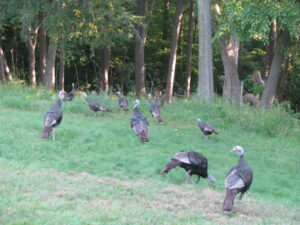
-
A dozen or so males routinely visited the yard.
-
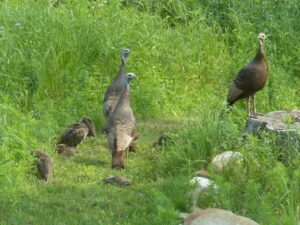
-
Rarely we would see hens with young.
About two years ago a threesome of males began visiting every day. Sometimes two or three times a day. We called them Huey, Duey and Louie. They seemed inseparable, and we never saw them alone. Late evenings we sometimes watched them flap up to tall tree branches to roost for the night.
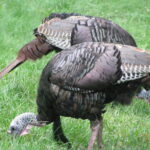
Huey and Louie
Then, only two visited. Huey and Louie. We never learned what happened to Duey. Maybe a predator enjoyed him for a meal. Or, he may have had an accident. It is a mystery, but we continued enjoying visits by the other two.
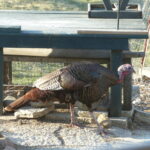
Lonely Louie looks for corn
One day Louie showed up alone. We haven’t seen his companion since. Lonely Louie is now trully a loner. If he’s in the yard and a flock of turkeys appears Louie stays away. He seems shunned by the others. Maybe he’s just shy.
He seems to miss his two friends. So do we, but we enjoy seeing Lonely Louie and know he appreciates the scoop of corn we toss out when he arrives.
by Winding Pathways | Mar 28, 2017 | Birds, Nature
Well, the turkey characters are at it, again! Up they come each morning even before sun up, looking quite fit and hale, and gobbling for breakfast. At Winding Pathways we get a kick out of the web pages and sporting flyers that detail all the equipment one needs to bag a turkey and how early one has to get up to beat the turkeys out of bed. Special camo clothes, calls, camo guns, shells. To the credit of the web sites, they do offer intriguing information on strutting, clutches of eggs, turkey senses, and habitat. A Kidzone site shares an interesting story of the “mix-up” of the name. and, of course, Audubon gives a great set of pictures and details about turkeys. All fun reading.
From the comfort of our home, we sip our coffee and watch a crew of seven meander up from the ridge where they roosted and another eight that saunter over from the neighbor’s trees. Then, it is the Sharks and the Jets (think West Side Story) as they squabble over the seed tossed out – not for them – but for the song birds. Or look at us with pathetic longing, trying to make us think they are starving. Ha!
Meanwhile, the less dominant males slide in for a feast.
Same with mating. The dominant males strut and intimidate and the less aggressive males sidle up to a female that is ready and mate. Maybe we will eventually have less pushy turkeys.
Enjoy this gallery of winter and spring turkey antics.
-
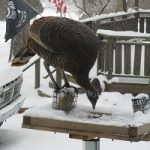
-
Urban forager
-
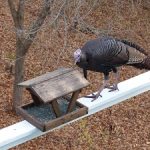
-
Making himself right at home.
-
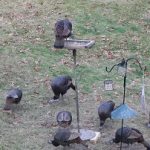
-
Feeding
-
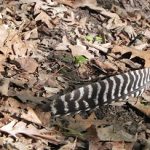
-
Feather in the woods
-
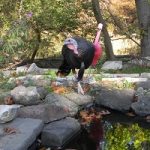
-
Flamingo checks out turkey.
-
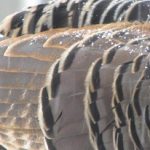
-
feathers
-
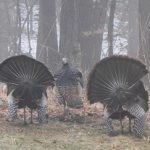
-
strutting
-
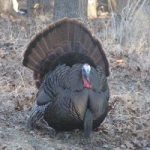
-
Fanning the tail
-
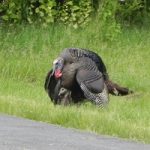
-
More intent on propagating than on strutting.


















